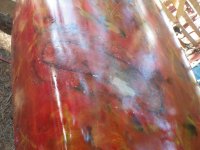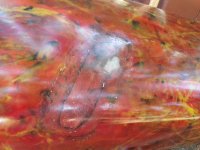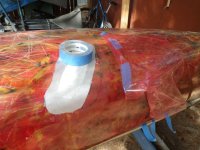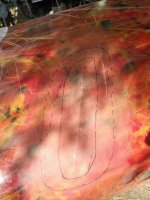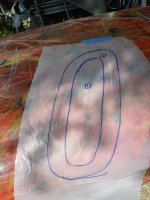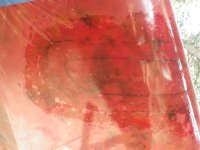The experiment and results.
The best test bed I could find was a scrap piece of vinyl siding, which will stand in nicely for the vinyl skin of an RX canoe. I wish it was something with more complex curves to test the “stretchability” of the plastic wraps, jut it’ll do. More on the usefulness of stretchability later.
I’m mostly curious to see which if any of the top films end up adhered to the epoxy, to see how the films flatten the would-be razor sharp seams that stand tall on fiberglass tape and how each smoothes out kevlar felt (which, I know, is a crap material, but it’s still what is included in most skid plate kits).
I’ve got bags of scrap glass tape and kevlar felt. Know I know why I kept it, and any other potentially usable piece of scrap material. It’s not that I’m cheap, it’s that I’m, um, experimental, or some subset of syllables therein.
I do have a couple of harder-to-come by films on hand; peel ply and a roll of mystery labeled “Porous Release Film” made (I think) for vacuum bagging. I’m going to omit some other “films” that have good reputation but limited availability - lexan film, Xerox transparencies sheets and etc
The films:
Saran Cling Plus
Glad Press & Seal
Glad Cling Wrap
Reynolds Wax Paper
Porous release film
Peel ply
The vinyl siding bed has been scrubbed clean, dried and alcohol wiped. Time to cut some fabric and film, and mix some epoxy.
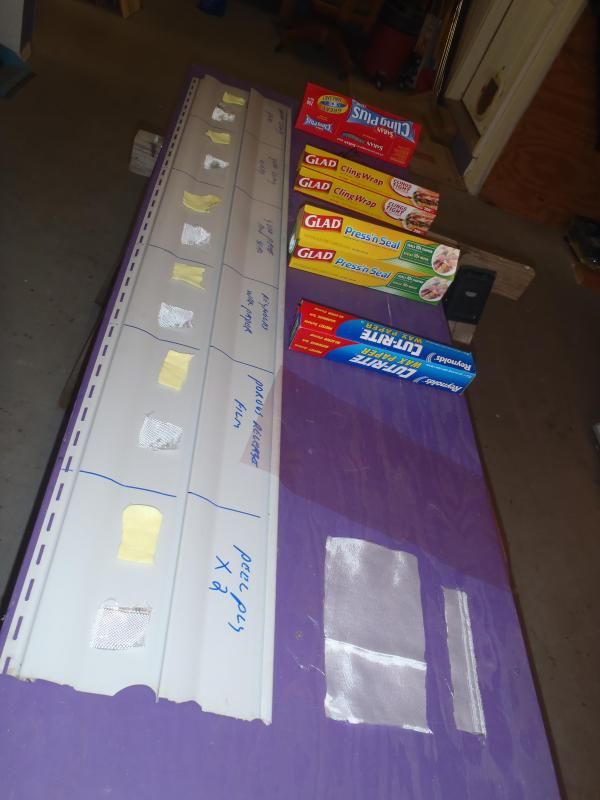
The Test: I painted a coat of epoxy (West System 105/206) on the vinyl siding, laid down pieces of kevlar felt and seamed edge glass and filled the cloth with an additional topcoat of epoxy resin in each test bed. I laid on the test films, smoothed each out with a gloved hand to eliminate what wrinkles I could and then rolled each film, pressing down with a short nap roller.
I weighed the “patches” down with Zip-lock sandbags, but removed them from the peel ply and (visibly perforated) porous release film while the epoxy was still green.

I could immediately confirm that I do not like working with stretchable plastic wrap. I can barely get kitchen leftover containers covered without ending up like a transparent and frustrated mummy, much less achieve a smooth and wrinkle-free film atop epoxy and cloth.
If there’s a trick to using stretch wraps atop epoxy and cloth it needs more than two hands.
I removed the sandbags atop the peel ply and porous film after 4 hours, which was almost too long. They were starting to get stuck and just barely came off without tearing open the Zip-locks and dispensing sand on the test bed. I live in trepidation of that happening when using sand bag weights.
Results:
I left the various films on for 12 hours before pulling them.
All of the test films knocked down the seamed edge of the tape and smoothed out the kevlar felt. The glass was barely visible and the loose end strands disappeared completely, with no stray frays poking up like composite lancets, and the cut sides of the kevlar felt were beveled smooth along the edges and not standing abrupt. So far so good.
Saran Cling Plus – It released cleanly except for one small shard of Saran that was trapped in a wrinkle. The resin was hardened, but there were many (many) sharp wrinkles and crinkles that would necessitate a lot of sanding. Not a pleasing surface.
Glad Cling Wrap – Identical to the Saran Wrap in every way.
Glad Press and Seal – Far smoother with less wrinkles and crinkles than the previous two, but the resin still felt tacky. It either needed more cure time or that tackiness was sticky residue from the Press and Seal. I set the test panel out in the sun for a few hours and the Press and Seal test piece was even stickier. I’d guess that stickiness is residue from the top film. Nix that one - Press and Seal is best avoided for epoxy work.
Reynolds Wax Paper – The cleanest release and smoothest epoxy/fabric surface of any of the grocery store products, with only a few small wrinkles/crinkles. I didn’t see or feel any waxy residue, but I’d want to lightly sand and clean that area just to be sure; wax would be a horrible contaminat to leave in place before topcoating.
Peel Ply – As expected the best of the lot and the easiest to work with, leaving a very faint weave pattern from the peel ply fabric. No wrinkles, no crinkles baby butt smooth.
Porous Release Film – Very clean release, but the epoxy surface is almost as wrinkled as with the two “cling” plastics.
Summary:
All of the materials released after a 12 hour cure, with one wrinkle trapped shard. In the previous plastic wrap experiment years ago (using poly resin) I had clamped the films down and found a good bit plastic trapped in compressed wrinkles and crinkles, especially with the Saran Wrap.
For a flattish surface or a simple curve wax paper seems to be the best, or at least easiest to work with, of the grocery store products. However wax paper will leave sharp-edged pockmark voids if the area is at all resin starved and will wrinkle if “forced” to take too much of a curve.
For complex curves one of the stretchable cling products “might” work if laid in place with four hands stretching the material smoothly across the surface area. Or not, even taping down one side I have never had much smooth success trying to stretch plastic wraps, and the resulting wrinkles and crinkles were more of a PITA to deal with than using no release material at all.
Clarification: While the cling products “might” work with better stretching technique on the outside of a curve (ie canoe stems), on an interior curve like the chines plastic wrap would be a wrinkled and creased disaster to get into place. Wax paper would be easier to apply in that application.
The mystery “porous release film” (a reddish-translucent film perforated with small holes) was no better than the cling wrap plastics. I’m guessing it was intended for vacuum bagging.
Peel Ply – If you do epoxy work get you some.
By far the smoothest finish, wrinkle and crinkle free. The faint fabric weave sands far easier than jagged wrinkles and crinkles, and makes a beneficial mechanical bonding surface if left in place for additional epoxy coats. Cut on the bias or laid in multiple overlapping sections peel ply will wrap a stem curve, and it’s much easier than any cling wrap for working inside a hull.
The peel ply removes most amine blush, and I think some excess resin as well. I can’t prove this, but after using peel ply for a few years I have a feel for the least amount of resin necessary to fill the cloth, with any small amount of excess coming off with the peel ply.
Ah well, in for a penny, in for a pound. Before I put a year’s supply of plastic food wraps in the kitchen cupboard I’ll try a small test area using G\flex with each product to see how that sticks-to-dang-near-everything epoxy releases from the various films.
And if I feel energetic in a week or so I may try sanding down the wrinkles and crinkles to gauge the effort required, and topcoating with more epoxy to see what’s needed for a smooth surface.



